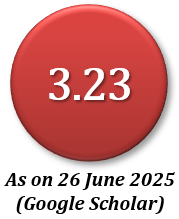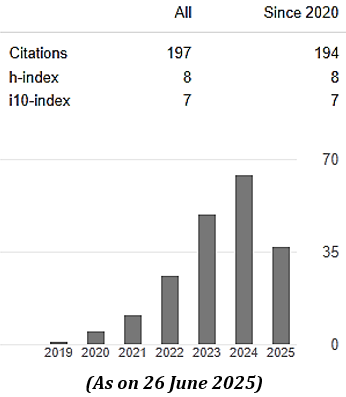A Review on Assessment and Management of Occupational and Health Risks in the Shipbuilding Sector of Bangladesh
Abstract
Bangladesh’s shipbuilding sector makes a significant contribution to the country’s economy. However, it is also associated with occupational risks for its workforce. This paper aims to review and explore existing literature on assessing and managing these risks within the context of Bangladesh shipbuilding industry. The review delved into different types of hazards encountered by shipyard workers, including physical, chemical, and biological dangers, by analyzing incident reports, safety audits, and exposure data elaborated in the literature. Furthermore, the review also examines established methods applied to the international and local shipbuilding industry for risk assessment and management and makes a comparison to find the gap in the literature. The study reveals a significant amount of literature covering various focus areas within the global shipbuilding sector. However, only a limited number of these works are relevant to Bangladesh shipbuilding industry, and among them, only very few papers deal with the Occupational Health and Safety assessment technique. This highlights a huge gap in the literature and suggests a need for more studies regarding Occupational Health and Safety management in Bangladesh shipbuilding.
Downloads
References
Acuner, O., & Cebi, S. (2016). An effective risk-preventive model proposal for occupational accidents at shipyards. Brodogradnja: Teorija i praksa brodogradnje i pomorske tehnike, 67(1), 67-84.
https://hrcak.srce.hr/file/228037
Ariany, Z., Pitana, T., & Vanany, I. (2022). Review of the risk assessment methods for shipbuilding in Indonesia. In IOP Conference Series: Earth and Environmental Science (Vol. 972, No. 1, p. 012056). IOP Publishing.
doi:10.1088/1755-1315/972/1/012056
AYDIN, M., & KOÇ, K. H. (2015). A study on compliance with occupational health and safety rules in yacht interior production. https://citeseerx.ist.psu.edu/document?repid=rep1&type=pdf&doi=7348601e91882c2ae11db7e1b8e26141838f34a4
Bangladesh Investment Development Authority (BIDA) Website. Last Accessed on 21 October, 2024. https://bida.gov.bd/shipbuilding
Barhad, B., Teculescu, D., & Crăciun, O. (1975). Respiratory symptoms, chronic bronchitis, and ventilatory function in shipyard welders. International Archives of Occupational and Environmental Health, 36, 137-150. https://doi.org/10.1007/BF01262318
Barlas, B. (2012). Occupational fatalities in shipyards: an analysis in Turkey. Brodogradnja: An International Journal of Naval Architecture and Ocean Engineering for Research and Development, 63(1), 35-41.
Buerke, U., Schneider, J., Rösler, J., & Woitowitz, H. J. (2002). Interstitial pulmonary fibrosis after severe exposure to welding fumes. American journal of industrial medicine, 41(4), 259-268.
https://doi.org/10.1002/ajim.10055
Celebi, U. B., Ekinci, S. E. R. K. A. N., Alarcin, F. U. A. T., & Unsalan, D. (2010, September). The risk of occupational safety and health in shipbuilding industry in Turkey. In Proceedings of the 3rd Int. Conf. Maritime and Naval Science and Engineering (pp. 178-184).
Cherniack, M., Brammer, A. J., Lundstrom, R., Meyer, J., Morse, T. F., Nealy, G., ... & Bruneau, H. (2004). Segmental nerve conduction velocity in vibration-exposed shipyard workers. International archives of occupational and environmental health, 77, 159-176.
Coggon, D., & Palmer, K. T. (2016). Are welders more at risk of respiratory infections?. Thorax, 71(7), 581-582.
DOGANAY, B., ÇAVUŞOĞLU, B., & GÜLER, Ç. B. (2023). A Study on Minimizing Potential Accidents in Ship Bunkering Operation Through Use of Failure Mode and Effect Analysis. Journal of Marine and Engineering Technology, 3(1), 1-13. https://doi.org/10.58771/joinmet.1291554
Efe, B. (2019). Analysis of operational safety risks in shipbuilding using failure mode and effect analysis approach. Ocean Engineering, 187, 106214. https://doi.org/10.1016/j.oceaneng.2019.106214
Export Promotion Bureau (EPB) Website. Last Accessed on 22 October, 2024.
Gillibrand, S., Ntani, G., & Coggon, D. (2016). Do exposure limits for hand-transmitted vibration prevent carpal tunnel syndrome?. Occupational Medicine, 66(5), 399-402.
Halder, P., Mehtaj, N., & Zakaria, N. M. G. (2023). Swot Analysis of the Shipbuilding Industry of Bangladesh in the Light of IR4. 0. Swot Analysis of the Shipbuilding Industry of Bangladesh in the Light of IR4. 0 (May 12, 2023). https://dx.doi.org/10.2139/ssrn.4446276
Haq, A. Z. M. (2022). Occupational Hazards of the Shipbuilding Industry in Bangladesh. Theory, Methodology, Practice-Review of Business and Management, 18(02), 93-102. https://doi.org/10.18096/TMP.2022.02.06
Hossain, N. U. I., Nur, F., & Jaradat, R. M. (2016). An analytical study of hazards and risks in the shipbuilding industry. In Proceedings of American Society for engineering management annual conference (pp. 18-21).
Huang, Z. Q., Tong, Y. T., Ren, L. X., & Ouyang, W. P. (2021, February). Hazard identification of portal crane in-use & research on its application in a shipbuilding company. In IOP Conference Series: Earth and Environmental Science (Vol. 657, No. 1, p. 012111). IOP Publishing.
Ibrahim, H., & Aris, K. A. A. (2022). Hazard Risk Management for Occupational Safety and Health on Phinisi Shipbuilding. Al-Sihah: The Public Health Science Journal, 65-75. https://doi.org/10.24252/al-sihah.v14i1.28785
Iqbal, K. S., Zakaria, N.M.G., & Hossain, K. A. (2010). Identifying and analysing underlying problems of shipbuilding industries in Bangladesh. Journal of Mechanical Engineering, 41(2), 147-158.
https://doi.org/10.24252/al-sihah.v14i1.28785
Islam, M. M., & Fatema, F. (2015) Working Conditions of Shipbuilding Workers in the Shipyards of Bangladesh: Problems and Consequences.
https://www.fbs-du.com/news_event/15053048457.pdf
Izci, F. B., Gökyay, O., & Barlas, B. (2024). Investigation of non-fatal occupational accidents and their causes in Turkish shipyards. International journal of occupational safety and ergonomics, 30(1), 33-40. https://doi.org/10.1080/10803548.2022.2157545
Kilburn, K. H., Warshaw, R., & Thornton, J. C. (1985). Pulmonary functional impairment and symptoms in women in the Los Angeles harbor area. The American journal of medicine, 79(1), 23-28.
Krstev, S., Stewart, P., Rusiecki, J., & Blair, A. (2007). Mortality among shipyard Coast Guard workers: a retrospective cohort study. Occupational and environmental medicine, 64(10), 651-658.
Liu, S., Guo, X., & Zhang, L. (2019). An improved assessment method for FMEA for a shipboard integrated electric propulsion system using fuzzy logic and DEMATEL theory. Energies, 12(16), 3162.
https://doi.org/10.3390/en12163162
Lokhande, V. R. (2014). Health profile of workers in a ship building and repair industry. Indian Journal of Occupational and Environmental Medicine, 18(2), 89-94.
Malherbe, L., & Mandin, C. (2007). VOC emissions during outdoor ship painting and health-risk assessment. Atmospheric environment, 41(30), 6322-6330.
Menteşe, Gözde, İ. N. C. E. Ebru, and Burcu Özcan (2017). " Investigation of Consciousness Occupational Health and Safety in Ship Construction Industry" Mühendis ve Makina 58.688: 53-78.
https://dergipark.org.tr/en/download/article-file/810817
Parveen, J. A., & Kabir, A. (2021). Prospects and Challenges of Shipbuilding Industry as a Growing Sector of Bangladesh Economy. Innovation in Economy & Policy Research, 2(2), 15-27.
Raju, A. S. (2023). Shipbuilding industry of Bangladesh: The chance to become a global player and economically dependent. Asian Journal of Research in Social Sciences and Humanities, 13(6), 1-11.
Article DOI: 10.5958/2249-7315.2023.00011.4
Rakhman, N. A. (2023). Identification and Analysis of Work Accident Risks in Daehan Shipbuilding Using Failure Mode and Effect Analysis (FMEA) and Improvement Approach with Job Safety Analysis (JSA) Method (Doctoral dissertation, Institut Teknologi Sepuluh Nopember). http://repository.its.ac.id/id/eprint/103986
Salminen, S. (2005). Relationships between injuries at work and during leisure time. Accident Analysis & Prevention, 37(2), 373-376.
Sari, I. P., Ilasabilirrosyad, A., Tanjov, Y. E., & Rahayu, S. M. (2023). Occupational Health and Safety Risks in the Shipbuilding Industry, Case Study at PT Blambangan Bahari Shipyard. Buletin Jalanidhitah Sarva Jivitam, 5(1), 45-53.
Seker, S., Recal, F., & Basligil, H. (2017). A combined DEMATEL and grey system theory approach for analyzing occupational risks: A case study in Turkish shipbuilding industry. Human and Ecological Risk Assessment: An International Journal, 23(6), 1340-1372. https://doi.org/10.1080/10807039.2017.1308815
Selikoff, I. J., Hammond, E. C., & Seidman, H. (1980). Latency of asbestos disease among insulation workers in the United States and Canada. Cancer, 46(12), 2736-2740.
Seokho, C., Sangwon, H., & Dae-Young, K. (2013). The Relationship between Unsafe Working Conditions and Workers’ Behavior and Their Impacts on Injury Severity in the US Construction Industry. Queensland University of Technology, 2, 1-45.
Shi, H., Wang, L., Li, X. Y., & Liu, H. C. (2020). A novel method for failure mode and effects analysis using fuzzy evidential reasoning and fuzzy Petri nets. Journal of Ambient Intelligence and Humanized Computing, 11, 2381-2395. https://doi.org/10.1007/s12652-019-01262-w
Shi, Q., Hu, Y., & Yan, G. (2023). A novel FMEA approach based on probabilistic linguistic best-worst method and TOPSIS with application to marine diesel fuel injection system. Journal of Intelligent & Fuzzy Systems, (Preprint), 1-20.
DOI: 10.3233/JIFS-230870
Shin, I. J. (2013). Comparative study on the institutional framework of risk assessment between german, UK and Korea, Japan in Asian Countries. Journal of the Korean Society of Safety, 28(1), 151-157.
https://doi.org/10.14346/JKOSOS.2013.28.1.151
Steel, J. (1968). Respiratory hazards in shipbuilding and ship repairing. Annals of Occupational Hygiene, 11(2), 115-121. https://doi.org/10.1093/annhyg/11.2.115
Storch, R. L., Hammon, C. P., & Bunch, H. M. (1988). Ship production.
Thiede, I., & Thiede, M. (2015). Quantifying the costs and benefits of occupational health and safety interventions at a Bangladesh shipbuilding company. International journal of occupational and environmental health, 21(2), 127-136. https://doi.org/10.1179/2049396714Y.0000000100
Trontin, C., & Béjean, S. (2004). Prevention of occupational injuries: moral hazard and complex agency relationships. Safety science, 42(2), 121-141.
Tsoukalas, V. D., & Fragiadakis, N. G. (2016). Prediction of occupational risk in the shipbuilding industry using multivariable linear regression and genetic algorithm analysis. Safety Science, 83, 12-22.
Yılmaz, F., & İlhan, M. N. (2017). Analysis of occupational accidents and risk factors occurred on Turkish flagged ships. Gemi ve Deniz Teknolojisi, (209), 55-70. https://dergipark.org.tr/en/pub/gdt/issue/34371/379734#article_cite
Yorio, P. L., & Wachter, J. K. (2014). The impact of human performance focused safety and health management practices on injury and illness rates: Do size and industry matter?. Safety science, 62, 157-167.
Zahan, T. (2016). Exposition of aspiration: shipbuilding journey through design Patiya, Chittagong (Doctoral dissertation, BRAC University).
Zakaria, N. M. G., Iqbal, K. S., & Hossain, K. A. (2010). Performance evaluation of the contemporary shipbuilding industries in Bangladesh. Journal of Naval Architecture and Marine Engineering, 7(2), 73-82.
DOI: 10.3329/jname.v7i2.5407
Zakaria, N. M. G., Ali, M..T., & Hossain, K. A. (2011). An overview of Bangladeshi Shipbuilding in the light of competitive parameters. Journal of Shipping and Ocean Engineering, 1(2011), 8-19.
Zakaria, N. M. G. (2012). Moving forward with export oriented shipbuilding industries in Bangladesh. Journal of The Institution of Engineers (India): Series C, 93,373-382
MIJST follows the open access policy.

This work is licensed under a Creative Commons Attribution-NonCommercial 4.0 International License. This allows anyone to copy, share, distribute, and modify the work for non-commercial purposes, where the original work and source should be properly credited.
















